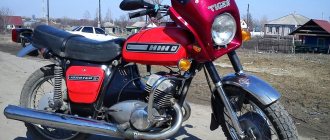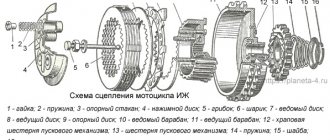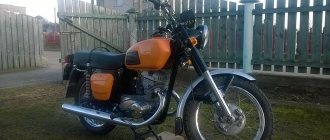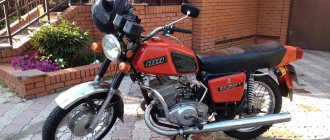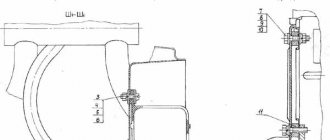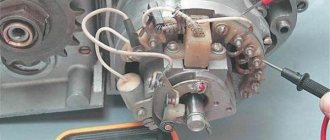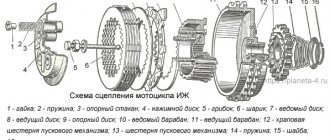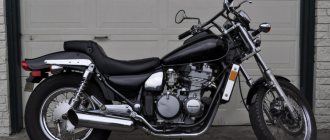The IZH Jupiter 5 motorcycle is a well-known monster of the Soviet motorcycle industry, produced from 1987 to 2008 . Massive and archaic, it represents a superficial reworking of previous generations of the series, in which the designers attempted to correct their shortcomings with relative success. Due to its good suitability for rural areas , the bike quickly became popular; moreover, due to a different engine, it was superior in power to its main competitor, the fifth “Planet”. Its engine was considered successful, and it was borrowed for another model of Izhevsk Motorcycle, the first Russian cruiser, which at one time was used even by traffic police officers.
Design
It would be naive to expect design delights from Soviet motorcycles. The bike looks similar to all other models produced by motorcycle factories of those years, but this is not surprising - the fifth generation was developed on the basis of the fourth, and the fourth - on the basis of the third, created back in the 70s of the last century. But many bikers, nostalgic for the old days, appreciate this rugged simplicity. Moto Izh Jupiter 5 does not stand out in any way externally from other bikes from the times of the USSR, which you can easily see for yourself by looking at the photo.
Technical characteristics of Izh Jupiter 5
In general, the characteristics of the Izh Jupiter 5 motorcycle corresponded to its time. But in the 2000s, when it continued to be produced, it could no longer compete with imported models. The Chinese had already flooded the market with budget, but still more modern models, and a flood of used motorcycles poured from Japan, Europe and the USA. The characteristics of the Izh Yu5 engine were not bad, but everything else was hopelessly outdated a couple of decades ago.
Engine
The technical characteristics of the engine are not amazing - two cylinders, 347 cubic meters . There is enough horsepower, as much as 24 , torque - 34 Nm . Compared to the previous generation, the engine lost 4 hp, but gained torque, and there was also noticeably more thrust at the bottom, so in general the characteristics of the Izh Jupiter 5 became more balanced. But the engine remained two-stroke , and oil mixed with gasoline must be poured into the gas tank in a ratio of 1 to 25 . But it can easily digest even AI-76, not to mention AI-80. The declared maximum speed is 125 km/h , and it can be achieved on Jupiter without a stroller. And if you look at the engine in cross-section, it turns out that it subtly resembles all the engines at once that were ever produced at the Izhevsk Motor Plant.
Transmission
Standard 4-speed transmission , where first gear is downshifted and all others are upshifted. It has never been reliable, but thanks to its high maintainability and availability of spare parts, Soviet motorcyclists quickly learned how to solve problems on their own. Some garage craftsmen even completely rebuilt the transmission, adding a fifth gear to the bike, but these were custom ones.
Chassis and brakes
The chassis was developed back in the 70s, if not earlier, and in Jupiter 5 it has remained virtually unchanged. A conventional steel frame with a telescopic fork in front and ancient shock absorbers a la “candle” in the rear, plus drum brakes on both wheels. The effectiveness of the suspension and braking system was mediocre even for its time, but they also had a significant advantage - endurance and maintainability. On modern motorcycles (except perhaps enduro), oil from the fork quickly begins to leak on rural dirt roads, and Izh Yu5, it seems, can ride without it at all. But we still do not recommend .
Electronics
The fifth generation Jupiter does not have the same electrical problems that the fourth had. In fact, this model is the same Jupiter 4, but with a number of corrected shortcomings, such as regular wiring problems. Gasoline consumption has also become lower thanks to a redesigned ignition. In general, the electrical circuit has changed slightly, but the weak points that regularly served as a source of headaches for owners have been removed.
Weight and dimensions
The dimensions of the bike can be called average, as well as its weight. How much does Izh Jupiter 5 weigh? By modern standards - quite a lot, about 160 kg , and this is only dry weight . But the motorcycle engine is located low, so the center of gravity is also shifted down. The relatively large weight is due to the fact that in the USSR they did not skimp on hardware, and plastic elements were practically not used. If something can be made from iron, it must be made from iron! That is why the weight of the Izh Jupiter 5 engine is about a quarter of its total mass, if we consider the specimen without a sidecar.
Controllability
This mastodon handles mediocrely , and not least because of the ancient design, and with a stroller the handling becomes even worse. But the cradles for Izh Jupiter 5 were also produced separately, so if you don’t need it, you can always disconnect it. But don't forget about weak brakes , which are not enough to effectively stop a massive bike. On the other hand, the Izh stroller is good because you can load a lot of spare parts and other goods into it when going on a long trip, since its volume allows this.
Fuel consumption
Compared to the previous generation, gasoline consumption has noticeably decreased, from 7-8 liters to 5.5-6 . The declared figures are about 5.9 liters at an average speed of 90 km/h . The quality of gasoline does not matter; the carburetor calmly consumes everything that burns. Tank volume - 18 liters .
I’ve been driving a new engine for half a year now and couldn’t write a post about it. So.
In the previous post, I described almost all the work, all the alterations and problems that got in my way. Naturally there were many mistakes, both technical and personal. In general, that’s why it was a test motor. Now I’ll tell you all the modifications that I made to my motorcycle for 2016. 1. I bought new USSR crankcases with live bearing seats. 2. For a long time I was looking for original Yu5 cheeks for a finger ngsh 21mm. I finally found and sent the connecting rods on the seperators to the master for repressing near Minsk. + I sent the flywheel to lighten it (1.8 kg) This is what happened.
Many thanks to Anatoly Lukyanenko for a job well done and for his invaluable advice. 3. Bearings as always YAP. 4. Erics seals
5. Box USSR Jupiter 3. 6. Wide basket with long springs and Atlant discs.
It looks like the motor itself is assembled, but the most interesting thing remains. “Top” I have long dreamed of a drill and finally bought this miracle. Of course, not a corner one and not even an original Dremel, but as practice has shown, about 10 pairs of pots were sawed down.
I sawed it to my friends and took up my cylinders.
I tried to adhere to Grigoriev’s theory, but it turned out that I went a little too far and the release phase reached 180. In general, but I understood what it was like)
After washing it down, I gave the cylinders for boring and honing. As it turned out from the nominal value, I had to sharpen it before the 2nd repair (Almot piston). Regarding the pistons: 1. Windows were cut out for a constant intake. (as I saw, I don’t say everything is in the previous post) 2. I turned out the refrigerators. 3.Sharpened the bottom to fully open the windows. (a controversial option, many people will say this is nonsense, I tried it and liked it, in general it definitely didn’t get any worse) 4. Made a “panacea for the wedge” 5. Aligned the piston with the purge. 6. Adjusted the weight of the pistons. By the way, the running-in was tough. Hard running-in. Up to 300 km, I used the engine carefully until 3500-4000, after which I squeezed out everything I could until 8000. There were no sticking conditions. I certainly don't impose my thoughts. Everyone chooses for themselves, but I am another confirmation that live running is not nonsense and the engine life does not suffer. While the cylinders were being bored, I started doing the wiring. Even though the charge on my original BPV was good, I wanted to get rid of the original brushes. (the brushes froze at high speeds) I did it as follows.
Horseshoe and RR from vases. Charging is stable at speeds from 1000rpm to 8000rpm. I did everything according to this scheme. Thanks to Yuri Zvarov for help in connecting. Vadim Hellsing for the pp and a couple of tips.
I decided to completely replace the front end with one from IZh PS.
The pendulum is in excellent condition, so I did not dare to disassemble it and replace the bushings with bearings. I only replaced the shock absorbers with Chinese gas-oil ones. Of course, I wanted to look for the Showa type from Japanese motorcycles, but the price is steep.
(don’t blame me for the background; I took a photo in the dorm) By the way, as further rides showed, the shock absorbers are very good for the money. The potholes are swallowed along the road, the rear does not throw or bounce. With the passenger, everything worked just fine, didn’t knock and worked great, overall I’m happy.
In addition to everything, I also installed an electronic speedometer, which won in the drawing, a temperature sensor and emergency lights.
+ I wanted to stick a fuse which, as it turns out, is a very useful thing and has a positive effect on the service life of the battery
Video: Dashboard A parcel with spare parts arrived)
I really liked the USSR carburetor repair kits with unusual flaps (alloy like metal). A little humor, here’s a comparison with the Honda Dio piston)
I bought my favorite NGK spark plugs, since the carburetors will need to be adjusted again, so preferably new spark plugs.
I put my heads under 95 gasoline.
I burned and painted the resonators again. Photos from repairs and setup.
Replaced the petals and ground the valve again. (on the new petals the motor began to work easier and I really liked it)
I adjusted everything again and set it up and it turned out that after washing it down the GTZ 240 was already small and something more was needed. As I later learned, GTZ from Solex carburetors are suitable for Pekar both with threads and other characteristics. I bought myself a bunch of GTZ in increments of 5 units and started changing and testing. It turned out that both cylinders needed 290gtzh. Although I thought that my appetite would increase, this did not bother me since the motorcycle is for sensations and not for economy. And then, when I checked the consumption, I was very surprised in the good sense of the word.
It seems I did everything I wanted. Below is a video and photos from the rides. Video 19 star rpm 6400 (not maximum) pipes are original.
The first rides were on February 20, the weather was good and we decided to go to the sea with friends.
That's probably all. I did almost everything I wanted both on the engine and on the entire motorcycle. The plans also include Japanese piston, good resonators and new brakes. I want to say thanks to people like Anatoly Lukyanenko, Yuri Zvarov, Sergey Sirko, Drobot Vovchik, Vadim Hellsing and others who helped me with the construction and advice.Repair and tuning
The products of the Izhevsk plant have never been famous for their reliability. But there is also an advantage in this - being the first motorcycle for a novice biker, some “Izhak” acted as a “learning desk”, helping to learn not only driving, but also independent maintenance and repair.
Repair
The gearbox causes complaints . It works clumsily, and problems sometimes arise with it, as with the clutch.
Spare parts
Finding them is not difficult, because at one time the Izhevsk plant riveted a fair number of motorcycles. The prices are low, but in some cases it is cheaper and easier to buy a “donor”, from which you can remove everything you need as needed.
Tuning
It is not easy to somehow modify a Soviet bike. Typically, owners reduce all changes made to visual tuning. Sometimes the carburetor is replaced with a Japanese or Chinese one - this relatively inexpensive operation helps avoid many potential problems.
Motorcycle modifications
The basic model had the index IZH 6.113 - 010 - 01, and the version with a side stroller - 6114 - 010 - 01. The “ Lux ” modifications were also produced (cradle, spare wheel, toothy tires, fairing, protective arches, trunk) and “ Tourist ” ( the same thing, but without the fairing, trunk and arches). Subsequently, the bike was modernized many times, receiving a different carburetor, a disc front brake, and a more energy-intensive fork with pneumatic adjustment. There is also a version with a cargo side trailer, but this is vanishingly rare these days. Jupiter 5 of the transitional model also comes across on sale, but this definition usually hides just one of the early modifications.
A stroller is a must
Economic motorcyclists preferred the Izh Jupiter 3 with a sidecar, the design of which made it possible to carry not only a third passenger, but also a fair amount of cargo. First, the BP 65 model was installed. Then it was replaced by a new modification BP-1, which had a sliding top for ease of passenger boarding.
Installing a side trailer requires wheel alignment. Adjustment is made by moving the front side hinge on the frame. The motorcycle, equipped with a sidecar, was marked Izh Jupiter-3K. More practical was, perhaps, the M-72 Ural.
Advantages and disadvantages
Despite all the modernization, the Izh motorcycle has both advantages and weaknesses. Powerful even by modern standards, it is clumsy, not very reliable, and requires constant attention. However, first things first.
Advantages
- Power . It is enough for a comfortable ride even today.
- Possibility to buy Izh Jupiter 5 with a cradle .
- Low price of used motorcycles on the secondary market.
- Maintainability and affordable cost of spare parts.
- Moderate dimensions - length, width, saddle height.
Flaws
- High fuel consumption , up to 6 liters per 100 km. And the fuel needs to be mixed with 2 tons of oil, which is inconvenient to do at a gas station.
- Motorcycle weight . It is felt, especially when maneuvering at low speeds.
- Low reliability of some components. In particular, problems with the gearbox are common.
Main problems and their solutions
Disassembling the IZ Jupiter 5 engine, the video of which is presented below, is carried out not only as problems arise, but also for preventive purposes. For example, cleaning the carburetor is one of the conditions for maintaining stable engine operation.
The IZ Jupiter 5 engine diagram is simple even for inexperienced motorists. Therefore, during repairs there will be no difficult issues. In most cases, breakdowns occur due to the negligence of owners who improperly operate the moped and do not perform regular maintenance. For example, incorrect selection of oil for a particular time of year. So, if any part wears out, it must be replaced.
- Spark plug.
- Cylinder head of a motorcycle engine.
- Motorcycle engine cylinder.
- Exhaust system window.
- Cylinder piston.
- Cylinder piston ring.
- Bypass system channel.
- Motorcycle piston pin.
- Crankshaft connecting rod.
- The left half of the engine crankcase.
- Leading star.
- Left crankshaft axle shaft.
- Clutch system spring.
- Adjustment type screw.
- Pressure clutch disc.
- Pedal on the gearbox (gearbox).
- Starting pedal.
- Clutch discs.
- Gearbox fork.
- Half of the engine crankcase is right.
- Cylinder head of a motorcycle engine.
- Motorcycle engine cylinder.
- Motor flywheel.
- Cover of the crank chamber of the Izh Jupiter 5 engine.
- Motorcycle generator.
- Moto breaker cam.
- Gearbox gears.
- Gearbox gears.
- Cam for automatically turning on/off the clutch mechanism.
Owner reviews
I bought my Izh U5 new from a store in 2004, drove it for five years, but had less than 10 thousand miles on it. Then the mot collected dust in the garage for four years, then he gave it to his son so he could study. Izhak started up after a long stay without problems, after replacing the battery and fluids. The technology is primitive, but tenacious; if only I had spare parts, this motorcycle will outlive me. Arseny, Novosibirsk.
An excellent option for the village, you can buy it alive for 10-15k, the tank lasts a long time, anyone can eat gasoline. There are a lot of minor breakdowns, but everything can be repaired easily. The Izh engine is high-torque and gets out of the mud on its own if the tires are suitable. My pepelats is generally ancient, a transitional model, but there are minimal differences even from the most recently released Jupiters. The spare parts all fit; if they don’t fit, they are filed and fit. Alexander, Usolye-Sibirskoe.
I bought my Jupiter5 back in 1990, the old man is still alive, periodically takes me around the dacha when I don’t want to drive the car on dead roads - I feel sorry for the suspension. Spare parts cost a penny, but something breaks every week))) And so the Jup is a normal moto for its time, the performance characteristics correspond to the price and years of development. Sergey, Syktyvkar.
Conclusion
Izh Jupiter 5 was structurally and morally outdated even before production began, but it still remains in demand in remote regions, where survivability and maintainability are valued rather than design. And as a first motorcycle , because it is capable of teaching both how to ride and how to repair your steel horse.
Specifications
| Maximum engine power: | 24 HP |
| Torque: | 34 Nm |
| Working volume: | 347.6 cm3 |
| Motor type (cylinder arrangement, number of strokes): | two-stroke, two-cylinder |
| Number of cylinders: | 2 |
| Number of valves: | |
| Intake type (Injector / Carburetor): | |
| Bore and stroke: | |
| Starting system (Electric starter, kick starter): | |
| Maximum speed in km/h: | 125 km/h |
| Cooling system: | Air cooling |
| Transmission (gearbox): | 4-speed, manual |
| Clutch (Dry / Wet): | |
| Drive unit: | Chain |
| Frame: | Steel |
| Chassis | |
| Suspension (front/rear travel): | |
| Brakes (Front/Rear): | |
| Wheels / Tires / Rubber: | |
| Dimensions and weight | |
| Dimensions (Length / Width): | |
| Seat height: | |
| Ground clearance: | |
| Curb weight: | |
| Wheelbase: | 1450 mm |
| Weight: | 160 kg |
| Battery capacity: | |
| Year of release: | |
| Country of Origin: |
Adjustment data, mm:
Gap between breaker contacts - 0.4-0.6 Gap between spark plug electrodes - 0.6-0.7 Free play at the end of the clutch lever - 5-10 Free play at the end of the handbrake lever - 2-5 Free play at the end foot brake lever – 10-15 Free play of the throttle cable and corrector – 1-2 Ignition timing to TDC. – 2.4-2.8 Rear wheel drive chain slack – 20-25 Air pressure in tires, kgf/cm²: Front tire – 1.5 +0.1 Rear tire – 2.5+0.1 Sidecars – 1, 5+0.1
Back to contents — ↑
